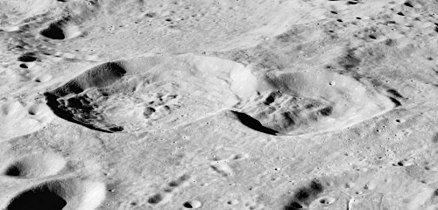 Lunar Orbiter 1 image of Shirakatsi crater (left) and Dobrovolʹskiy crater (right) | |
| Coordinates | 12°50′S 129°41′E / 12.83°S 129.68°E |
|---|---|
| Diameter | 38.4 km (23.9 mi) |
| Depth | 3.8 km (2.4 mi)[1] |
| Colongitude | 231° at sunrise |
| Eponym | Georgiy T. Dobrovolʹskiy |
Dobrovolʹskiy is a small lunar impact crater on the Moon's far side. The northwest part of its rim is intruded upon by the somewhat larger crater Shirakatsi, and the outer rampart of that feature covers most of the interior floor of Dobrovolʹskiy. Very little of the original floor now survives, with a small section near the southern inner wall. The remainder of the crater rim is somewhat circular and only mildly worn.[2]
To the north the southern rim of the much larger crater Perepelkin is intruded upon by Shirakatsi, and the three form a brief, curving crater chain. To the southeast of Dobrovolʹskiy is the crater Volkov.
In 1973, the crater was named after cosmonaut Georgiy T. Dobrovolskiy, who died during the Soyuz 11 mission.[3]
Satellite craters
[edit]By convention these features are identified on lunar maps by placing the letter on the side of the crater midpoint that is closest to Dobrovolʹskiy.
| Dobrovolʹskiy | Latitude | Longitude | Diameter |
|---|---|---|---|
| D | 12.2° S | 130.6° E | 49 km |
| M | 14.6° S | 129.6° E | 31 km |
| R | 14.0° S | 127.7° E | 24 km |
Views
[edit]-
Oblique view of the collapsed wall between the craters (Apollo 17 panoramic camera)
-
Oblique Apollo 15 Mapping camera image
-
Apollo 17 Mapping camera image
References
[edit]- ^ LTO-83C3 Dobrovolskij, Lunar Topographic Orthophotomap (LTO) Series, Publisher: Defense Mapping Agency, Scale: 1:250,000
- ^ Figure 148 in Chapter 5 of APOLLO OVER THE MOON: A View From Orbit (NASA SP-362, 1978)
- ^ Dobrovolʹskiy, Gazetteer of Planetary Nomenclature, International Astronomical Union (IAU) Working Group for Planetary System Nomenclature (WGPSN)
- Andersson, L. E.; Whitaker, E. A. (1982). NASA Catalogue of Lunar Nomenclature. NASA RP-1097.
- Blue, Jennifer (July 25, 2007). "Gazetteer of Planetary Nomenclature". USGS. Retrieved 2007-08-05.
- Bussey, B.; Spudis, P. (2004). The Clementine Atlas of the Moon. New York: Cambridge University Press. ISBN 978-0-521-81528-4.
- Cocks, Elijah E.; Cocks, Josiah C. (1995). Who's Who on the Moon: A Biographical Dictionary of Lunar Nomenclature. Tudor Publishers. ISBN 978-0-936389-27-1.
- McDowell, Jonathan (July 15, 2007). "Lunar Nomenclature". Jonathan's Space Report. Retrieved 2007-10-24.
- Menzel, D. H.; Minnaert, M.; Levin, B.; Dollfus, A.; Bell, B. (1971). "Report on Lunar Nomenclature by the Working Group of Commission 17 of the IAU". Space Science Reviews. 12 (2): 136–186. Bibcode:1971SSRv...12..136M. doi:10.1007/BF00171763. S2CID 122125855.
- Moore, Patrick (2001). On the Moon. Sterling Publishing Co. ISBN 978-0-304-35469-6.
- Price, Fred W. (1988). The Moon Observer's Handbook. Cambridge University Press. ISBN 978-0-521-33500-3.
- Rükl, Antonín (1990). Atlas of the Moon. Kalmbach Books. ISBN 978-0-913135-17-4.
- Webb, Rev. T. W. (1962). Celestial Objects for Common Telescopes (6th revised ed.). Dover. ISBN 978-0-486-20917-3.
- Whitaker, Ewen A. (1999). Mapping and Naming the Moon. Cambridge University Press. ISBN 978-0-521-62248-6.
- Wlasuk, Peter T. (2000). Observing the Moon. Springer. ISBN 978-1-85233-193-1.




Well, that’s interesting to know that Psilotum nudum are known as whisk ferns. Psilotum nudum is the commoner species of the two. While the P. flaccidum is a rare species and is found in the tropical islands. Both the species are usually epiphytic in habit and grow upon tree ferns. These species may also be terrestrial and grow in humus or in the crevices of the rocks.
View the detailed Guide of Psilotum nudum: Detailed Study Of Psilotum Nudum (Whisk Fern), Classification, Anatomy, Reproduction